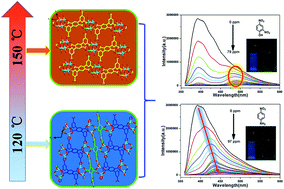Rapid and discriminative detection of nitro aromatic compounds with high sensitivity using two zinc MOFs synthesized through a temperature-modulated method†
Abstract
Two 3D MOFs (1 and 2) have been solvothermally synthesized by introducing a π-electron conjugated fluorescent aromatic polycarboxylate ligand under the modulation of reaction temperature. Intriguingly, complex 2 shows an unusual fluorescence thermochromism. Upon decreasing the temperature, the emission bands exhibit different variation behaviors which result in dramatic changes of the emission color. The fluorescence of 1 and 2 dispersed in DMF (N,N-dimethylformamide) can be selectively and sensitively quenched by using nitro aromatic compounds (NACs) with a fast response time of just 10 s, indicating that 1 and 2 are potential real-time response candidates for detecting NACs. More interestingly, when DNP (2,4-dinitrophenol) and PNA (p-nitroaniline) are introduced, distinctive fluorescence signals, which can discriminate them from other NACs, are observed, making 1 and 2 the rare materials that can distinguish different nitro aromatic molecules.


 Please wait while we load your content...
Please wait while we load your content...